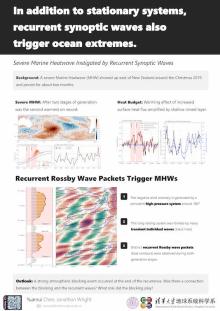2019/2020 Severe Marine Heatwave in the Southwest Pacific Instigated by Recurrent Synoptic Waves
Yuanrui
Chen
Department of Earth System Science, Tsinghua University
Poster
A severe marine heatwave developed in the Southeast Pacific during the austral summer of 2019--2020 that lasted for about two months. Using daily atmospheric and oceanic reanalysis products, we show that the formation of this severe marine heatwave proceeded in two distinct warming stages.
Both stages featured extremely shallow mixed-layer depths that amplified the warming effects of increased solar radiation at the surface. These factors were related to recurrent synoptic Rossby wave packets propagating through an upper-level ridge, which organized near-surface circulation anomalies that increased surface heat flux and suppressed wind-driven mixing, shoaling the mixed layer and triggering the intense marine heat wave. Blocking highs spawned by local and upstream recurrent wave packets also contributed to prolonging the heat wave. The origins and evolution of recurrent Rossby wave packets are poorly understood and their cumulative impacts are not well constrained; future work should target these issues.
Both stages featured extremely shallow mixed-layer depths that amplified the warming effects of increased solar radiation at the surface. These factors were related to recurrent synoptic Rossby wave packets propagating through an upper-level ridge, which organized near-surface circulation anomalies that increased surface heat flux and suppressed wind-driven mixing, shoaling the mixed layer and triggering the intense marine heat wave. Blocking highs spawned by local and upstream recurrent wave packets also contributed to prolonging the heat wave. The origins and evolution of recurrent Rossby wave packets are poorly understood and their cumulative impacts are not well constrained; future work should target these issues.

Poster file
Chen_Yuanrui_blocking_poster.pdf
(1.84 MB)
Meeting homepage
